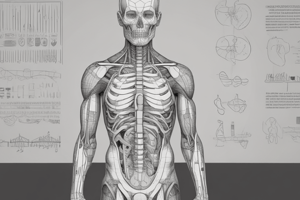Podcast
Questions and Answers
What is the primary function of the Gluteus Maximus and Medius muscles?
What is the primary function of the Gluteus Maximus and Medius muscles?
- Plantar flexion of the foot
- Flexion of the hip
- Dorsiflexion of the foot
- Extension of the hip and external rotation of legs (correct)
What type of muscle is the hamstring during flexion of the knee?
What type of muscle is the hamstring during flexion of the knee?
- Synergist
- Fixator
- Antagonist
- Agonist (correct)
What is the term for a decrease in muscle cell diameter due to neglect?
What is the term for a decrease in muscle cell diameter due to neglect?
- Dystrophy
- Hypertrophy
- Hyperplasia
- Atrophy (correct)
What is the site of attachment that moves during a contraction?
What is the site of attachment that moves during a contraction?
What is the term for a muscle that contracts during a contraction?
What is the term for a muscle that contracts during a contraction?
What is the primary function of the Iliopsoas muscle?
What is the primary function of the Iliopsoas muscle?
Which type of muscle tissue is responsible for creating the actions that pump blood?
Which type of muscle tissue is responsible for creating the actions that pump blood?
What type of muscle contraction occurs when the load is greater than the force, resulting in muscle fibers lengthening?
What type of muscle contraction occurs when the load is greater than the force, resulting in muscle fibers lengthening?
Which muscle is responsible for flexion of the shoulder and adduction of the humerus?
Which muscle is responsible for flexion of the shoulder and adduction of the humerus?
What type of muscle fibers are found in smooth muscles?
What type of muscle fibers are found in smooth muscles?
Which muscle is responsible for extension of the elbow and pronation of the forearm?
Which muscle is responsible for extension of the elbow and pronation of the forearm?
What type of muscle contraction occurs when the load is equal to the force, resulting in no movement?
What type of muscle contraction occurs when the load is equal to the force, resulting in no movement?
Which muscle is responsible for flexion of the lumbar spine and creation of intra-abdominal pressure?
Which muscle is responsible for flexion of the lumbar spine and creation of intra-abdominal pressure?
What type of muscle tissue is attached to bones by tendons and is controlled by nerve fibers?
What type of muscle tissue is attached to bones by tendons and is controlled by nerve fibers?
Flashcards are hidden until you start studying
Study Notes
Muscle Functions
- Maintain posture (neck, lower back)
- Enable locomotion (bony movement and body functions)
- Regulate heat (muscles release heat as a by-product of reactions)
Types of Muscle Tissues
- Smooth Muscles: Involuntary, located around internal organs, no striations, contract and relax slowly
- Cardiac Muscles: Involuntary, found in the heart, responsible for pumping blood, controlled by the autonomic neural system
- Skeletal Muscles: Voluntary, attached to bones by tendons, controlled by nerve fibers, striated, with slow and fast twitch types
Types of Muscle Contractions
- Concentric: muscle fibers shorten, load < force, angle between joints decreases
- Eccentric: muscle fibers lengthen, load > force, angle between joints increases
- Isometric/Static: muscle fibers stay the same length, load = force, no movement
Major Muscles
- Pectoralist Major: superficial part of the chest, flexion of shoulder and adduction of humerus
- Trapezius: neck and upper back, elevation and depression of scapula
- Latissimus Dorsi: superficial part of the back, extension of shoulder and abduction of humerus
- Deltoid: superficial part of the shoulders, flexion and extension of shoulder
- Biceps Brachii: anterior part of the upper arm, flexion of elbow and supination of forearm
- Triceps Brachii: posterior part of the lower arm, extension of elbow and pronation of forearm
- Rectus Abdominus: superficial part of the stomach, flexion of lumbar spine and creation of intra-abdominal pressure
- Quadriceps Femoris: anterior part of the femur, extension of the knee and flexion of the hip
- Hamstrings: posterior part of the femur, flexion of the knee and extension of the hip
- Gluteus Maximus/Medius: posterior side of the pelvis, extension of hip and external rotation of legs
- Iliopsoas: anterior side of the pelvis, flexion of the hip
- Gastrocnemius: posterior part of the shin, plantar flexion of foot
- Tibialis Anterior: anterior part of the shin, dorsiflexion of foot
Agonist vs. Antagonist Muscle Pairs
- Agonist: muscle that contracts during a contraction
- Antagonist: muscle that lengthens during a contraction and counteracts the movement of the agonist muscle
Muscle Origin vs. Insertion
- Origin: site of attachment that does not move during a contraction (proximal)
- Insertion: site of attachment that moves during a contraction (distal)
Atrophy vs. Hypertrophy
- Atrophy: decrease in muscle cell diameter/loss of muscle tissue due to neglect
- Hypertrophy: increase in muscle cell diameter/gain of muscle tissue due to stimulation
Studying That Suits You
Use AI to generate personalized quizzes and flashcards to suit your learning preferences.





